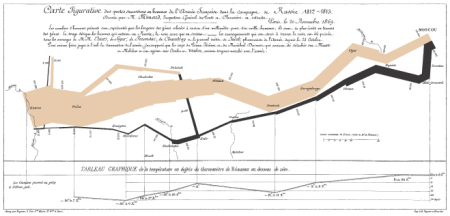The old saying that pictures say more than 1,000 words shows what manipulative power images truly have. For charts, however, that doesn’t mean much. To the contrary: we’d better add a few words so that our audience understands them at all.
Napoleon’s Russian offensive was a catastrophe. He started with 422,000 men in June 1812 and returned with less than 10,000 soldiers on October 7, 1813. His army had already lost 135,000 men two weeks into the campaign – although there were no major battles at this point. Napoleon wanted his troops to feed off the land during their advance but the enemy left nothing but ‘scorched earth’ during its retreat. Since they had no alcohol to sanitize the water, there was a rapid outbreak of dysentery. Before the battle of Smolensk on August 17th, disease, weakness and desertion had already decimated the troops to 175,000 men. Napoleon arrived in Moscow with 100,000 soldiers. He had already lost two-thirds of his main army – not to mention many horses.
Undoubtedly a graphical milestone: This 1869 visualization drawn by the engineer Charles Joseph Minard shows the data from Napoleon’s disastrous Russian campaign from 1812-1813. Without further explanation, however, it is more of an appeal than an analysis. Click on the image to enlarge.
Napoleon’s army faced many battles during its retreat. It lacked horses to pull the loads. The soldiers torched their wagons and left their dismantled canons behind. When winter arrived, they had no warm clothing. Since the horses had the wrong shoes, the number of accidents rose on the slick paths. They even burned the pontoons that they carried to build bridges just a few days before they reached the Beresina River. Lice thrived in the appalling hygienic conditions and transmitted typhus fever. Napoleon returned with less than 10,000 men.
Total: 213 words.
Minard’s graphic also describes the disaster. We see the troop size at each stage in the campaign – including its direction and location – on a two-dimensional map. Below the image, we also see the temperature scale. This visualization is often quoted as a masterpiece. If it stands alone, we can interpret a lot from – but also into – it. The temperature scale could lead us to believe that it was the harsh Russian winter that defeated Napoleon. But that is only part of the truth. I gave this picture 213 words. In my opinion, however, that still isn’t enough. Nonetheless, these words helped the graphic because they shed more light on the circumstances.
Napoleon lost for many reasons. However, we can visualize very few of them in a graphic drawing. And that is exactly the point. Our world is difficult, beautiful, complex and colorful. Although graphics are very important in the world of abstraction, they can only capture a piece at a time. Words provide the necessary means to complement our graphical argumentation. In other words, he who draws must write as well.

